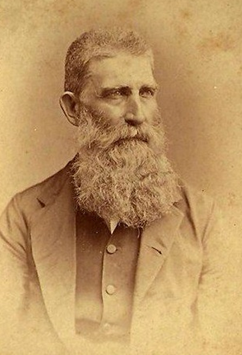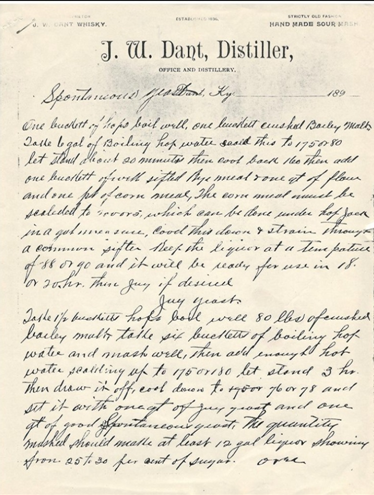J.W. Dant: Family Tradition to Log Still Distillery
When us bourbon folk are sitting on our porch sipping from our favorite bottle and talking about bourbon history, it is easy to come up with iconic names, distilleries, and brands such as Dr. James Crow, Colonel E.H. Taylor, Stitzel-Weller Distillery, and Colonel Blanton to name a few. Perhaps one of the forgotten names and brands, but one of the longest standing, is J.W. Dant. In today’s bourbon world, the J.W. Dant brand is known as a bottled-in-bond brand from Heaven Hill that is generally considered a solid bourbon at a cheap price. In our discussions about bourbon legends, not one time does the name J.W. Dant or the Dant family come up. Today we are going to change that.
Joseph W. Dant (1820-1902)
The Dant legacy starts all the way back in 1836 with a man named Joseph W. Dant. Joseph Dant was born in Marion County Kentucky in 1820. At the very young age of 16, he fashioned a still out of a large Poplar tree and began to still whiskey at Dant’s Kentucky Station. A log you say? Yes, a log. Back in those times, when a distiller could not yet afford a copper still, he could split and hollow out a large log. He would then insert a copper tube and the two halves would be rejoined. The hollow areas would be filled with fermented mash and steam would feed through the piping, creating the distillation process. This process was known as “running it on a log”. It was a crude method but in the right hands, and Dant seemed to have those, acceptable whiskey could be produced.
Joseph grew his own grain and hand-picked the best grain for his whiskey. Dant also built his own barrels that eventually led to his creation of his own cooperage. Another of Dant’s incredible feats include him producing more whiskey than the locals could buy and consume. Joseph proceeded to build a raft and float it down the Mississippi to New Orleans. It is rumored that Dant himself made the trek down the Mississippi on the raft on three different occasions with at least one occasion ending with him walking 600 miles back to Kentucky.
In 1849 Dant married Ann Ballard and together they produced ten children in total; seven boys and three girls. As the years progressed, the popularity of Dant’s whiskey grew and so did his need for high operational output. In 1850, Joseph produced his first barrel of the brand called Yellowstone.
Handwritten yeast recipe from J.W. Dant (around 1890)
By 1870, he had managed to save enough resources to build a new distillery. This distillery was different from others as it was built to take advantage of gravity. The mash tub was much higher than the fermenters. Using a very large pipe, Dant was able to fill his tubs without pumping. The same thought process was used in bottling as the whiskey was filtered by gravity to a tank and to the bottling line. After the passing of the Bottled in Bond Act, the warehouse near the distillery became a bonded warehouse, giving the brand and product additional respectability within the marketplace.
In the 1880’s, Joseph Dant retired and the company was turned over to two of his sons. We will review each of their paths separately, starting with J.B. or Bernard. Bernard continued to grow the Dant Distilling Company and in 1897 the company is incorporated. In 1902, Joseph Dant died but the company and the family brand name thrived under the leadership of another son, George Dant. In 1912, J.B. Dant opens a Taylor and Williams distillery at Gethsemane to produce Yellowstone separate from J.W. Dant, due to increased demand. From 1902 until prohibition, the J.W. Dant companies would prosper but at the coming of prohibition, the distillery was forced to close. During prohibition, some of their stock was purchased by the Stitzel-Weller group as they were part of six distilleries that had a permit to sell medicinal whiskey during the times of prohibition.
In 1936 on the heels of the repeal of prohibition, the J.W. Dant distillery reopens but the Gethsemane distillery had already been sold in 1934 to Timkin Roller Bearing Company. Bernard built a new facility in Jefferson County where he was listed as the Vice President of the company. Bernard died several years later at 89. In 1941, Bernard sold the original J.W. Dant distillery and the facility was shut down for good in 1951. In 1940, the Gethsemane distillery was purchased by National Distillers who then sold the distillery four years later to Arm and Hammer to be run as the United Distillers of America. In 1952, Schenley purchases the distillery and the JW Dant “Charcoal Perfected” product line is introduced in 1957. In 1987, United Distillers buys back the distillery and produced for six years until the brands are sold to Heaven Hill and the distillery is shut down permanently.
There was a third brother that followed in his father’s distilling footsteps. John Procter Dant. Early on, John worked for Joseph at the Dant distillery. In 1890, John went out on his own and bought a distillery located in what is now St. Francis, Kentucky. The distillery was called the Old Danton Distillery after his flagship brand Old Danton. After several years, John sold out and moved to Louisville where he started a wholesale liquor house. The Louisville operation stopped in 1919 with the introduction of prohibition. After repeal, John built a new distillery at Meadowlawn in Jefferson County. This was called the John P. Dant Distillery. He also leased the Grosscurth Distillery in Anchorage and incorporated the two distilleries as Meadownlawn Distillery Company. The two distilleries had a combined mashing capacity of 471 bushels per day. They owned six warehouses with a total capacity of 7,500 barrels. From those distilleries, John produced the brands Old Boone and Distiller’s Choice. John died in 1944 and his son, John Jr. ran the company until its sell off in 1950.
Old Gethsemane Distillery. Site of the new Log Still Distillery
This article tells quite a story of the Dant family’s impact on the industry and we only dove into the patriarch of the family and two of his sons. Even though there is no longer a Dant distillery, the legacy of the product lives on through the J.W. Dant bottled in bond product. There are living descendants of the Dant family still alive and active today although not in the bourbon industry. The story of J.W. Dant, the distilleries, and their product is another in a long line of bourbon history that should be shared. The next time you open up a bottle of J.W. Dant Bottled-in-Bond, think back to that old log where Joseph distilled the first batch of his whiskey and launched his family business.
Barring a label purchase from Heaven Hill, the Dant family will never again produce bourbon under their family name, however they will be producing bourbon again soon. In an announcement in 2019, Wally Dant informed the bourbon industry that he would be resurrecting the old Gethsemane Distillery in Nelson County. The resurrected distillery will be called Log Still Distillery; paying homage to his ancestor Joseph Dant and his process of distilling whiskey through a log still. Wally and his team will not be distilling through a log, but the bourbon world is excited about an iconic bourbon family producing bourbon at a once iconic Kentucky distillery.



